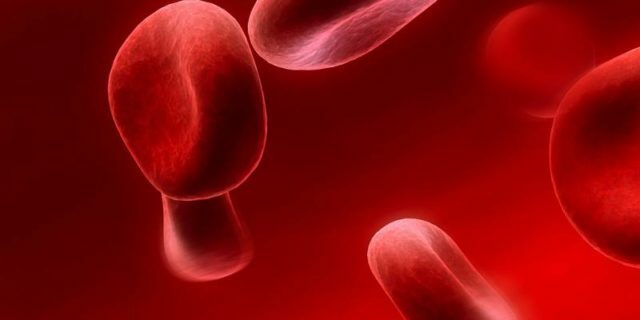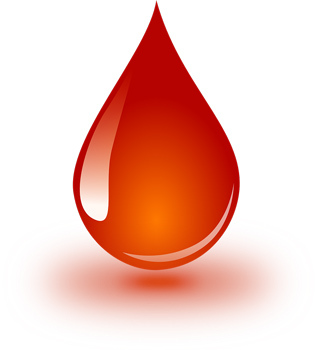
Contents of the page
- 1 Compatibility of blood groups - what you need to know
- 2 Blood groups - description of
- 3 What you need to know before conception?
- 4 Table of compatibility of blood groups - 1, 2, 3 and 4
- 5 What you need to know about the incompatibility of blood?
The compatibility of blood groups for conception of a child is a very important parameter that determines the normal course of pregnancy and the absence of disturbances in the formation of the fetus. This topic became relevant with the development of genetics as a science. Of course, any family should be built on the basis of mutual respect, love and trust, the existence of common views on the style, way of life and much more. However, the basis of conception, gestation and the birth of a healthy and happy baby should be the biological and genetic compatibility of future parents.
In any of the centers for family planning, many hours are devoted to this issue. We are talking about blood groups and rhesus factors, and that if incompatibility of these characteristics in future parents, pregnancy can be difficult for a potential mother, and for a baby, a "blood conflict" threatens the risk of inappropriate intrauterine development.
Compatibility of blood groups - what you need to know

Blood is a unique biological fluid that provides all vital functions of the body. This is the basis of life, centered in small blood cells.
Erythrocytes constitute the bulk of the blood and have a complex biochemical composition. Their main function is to transport oxygen to all the anatomical structures of the body. At the same time, the composition of blood cells in different people is not the same, it can differ in the presence or absence of certain proteins.
It is the proteins or antigens that make up the red blood cells that divide the blood into groups. In addition, each erythrocyte carries a certain Rhesus factor, which allows people to be divided not only into blood groups, but also in such a status as a Rh-negative or rezus-positive factor.
Human blood can belong to one of four groups, each of which is distinguished by a set of specific proteins( antigens) that make up the basis of red blood cells. Antigens are usually referred to as A and B. Blood cells of the 1st blood group do not contain antigens, in the red cells of the 2 groups there are proteins A, in the third group there are proteins B, and the blood cells of group 4 contain both antigens( A and B).
Blood groups - a description of

Blood groups formed during the evolution of mankind. Scientists believe that initially, all people had 1 blood group. Then, as a result of mutations, mixed marriages and changes in living conditions and the existence of different peoples, other blood groups began to form.
- 1 group is the oldest, its age is more than 60 000 years. This is the blood of hunters and gatherers, whose diet was dominated by meat. The peculiarity of this group is that the erythrocytes do not contain protein-anti genes.
- 2 group - was formed more than 25 000 years ago as a result of a change in diet, in which meat food was replaced by vegetable. The blood of group 2 belonged to the first farmers and was formed during the transition to a settled way of life associated with the domestication of cattle and the cultivation of cereals. Evolution gradually changed the human digestive and immune system, forcing them to adapt to the assimilation of plant foods, respectively, and the blood group changed. As a result of the mutation in the blood cells of the 2nd blood group, a specific protein( antigen) appears. A.
- 3 group - the blood of nomads and pastoralists. It first appeared as a result of a mutation in the representatives of the Mongoloid race, and along with them migrated from the steppe plains to Europe. The erythrocytes of this blood group contain the antigen B.
- 4 blood type - the youngest and most mysterious, its blood cells contain just two antigens( AiB).It is believed that it appeared 1500 years ago as a result of the mixing of blood of various races. This group of blood is considered the most biologically complex, and the rarest is the 4 group with negative rhesus.
What do I need to know before conception?

The planning of pregnancy and childbirth needs to be approached competently. Reproductive specialists advise to determine in advance the blood group and the Rh factor of both spouses, this will help to avoid possible complications and will help to determine what qualities the child will inherit from both partners.
Especially important is the test for Rh-compatibility, which will prevent dangerous consequences, in particular hemolysis in pregnancy. It should be remembered that if a woman has a positive, and a man - a negative Rh factor, a rhesus-conflict develops, in which the mother's organism perceives the fetus as an alien organism and starts to fight with it, producing antibodies. This situation is dangerous not only for women, but also for the fetus, as the probability of development of hemolytic disease in the baby is significantly increased.
If you determine in advance whether you can conceive by blood group, you can maximize the safety of your mother and future baby. And using the rule of Ottenberg, a physician can find out in advance what diseases can occur during pregnancy, approximately establish a scheme for combining chromosomes and Rh factor - the future child, as well as determine the color of his eyes, hair, height and other features.
The ratio of the blood groups of the mother and the father is an important point, but their incompatibility does not mean that they can not become pregnant, but only points out that problems may arise in the process of bearing a child. However, today, we can safely say that this thesis is not undeniable. The future genetic signs of the planned baby, as the actual fact of his conception and intrauterine development, depend on the combination of the characteristics of both parents. Two main indicators are taken into account:
- blood type;
- Rh factor.
Directly on the possibility of onset of conception, none of these indicators is affected. The incompatibility of partners is important even when the child is born, but in this case the conflict between the blood of the fetus and the mother does not always develop. Nevertheless, knowing the possible risks is necessary, it will allow to take certain measures in advance and plan the successful course of pregnancy, taking into account possible pathologies and difficulties.
Blood Group Compatibility Chart - 1, 2, 3 and 4

The blood group compatibility chart for conception of the baby will help you to calculate how comfortable the mother will be during the gestation and with which blood group the baby will be born.
| Father data | Mother data | Probability of incompatibility | Characteristics inherited by the child |
| I( O) | I( O) | - | I( O) |
| I( O) | II( A) | - | II( A) / IO), in the probability of 50/50 |
| I( O) | III( B) | - | III( B) / I( O), in the probability of 30/70 |
| I( O) | IV( AB) | - | II(A) / III( B), in the probability of 50/50 |
| II( A) | I( O) | 80% probability of developing a "blood conflict", complications and abnormalities in bearing | I( O) / II( A),in the probability of 60/40 |
| II( A) | II( A) | I( O) / II( A), in the probability of 30/70 | |
| II( A) | III( B) | 70% probability of developing a "blood conflict", complications and pathologies when carrying 50% probability of miscarriage or premature birth | I( O) / II( A) / III( B) / IV( AB), in equal parts of probability |
| II( A) | IV( AB) | - | I( A) / III( B) / IV( AB), with an equal degree of probability |
| III( B) | I( O) | 80% probability of developing a "blood conflict", complications and pathologies when carrying 40% probability of miscarriage or premature births | I( O) / III() , in the probability of 30/70 |
| III( B) | II( A) | 60% probability of developing a "blood conflict", complications and pathologies when carrying | I( O) / II( A) / III( B) / IVAB) with an equal probability of |
| III( B) | III( B) | - | I( O) / III( B), in the probability of 50/50 |
| III( B) | IV( AB) | - | IO) / III( B) / IV( AB), with an equal degree of probability |
| IV( AB) | I( O) | 100% probability of developing a "blood conflict", complications and pathologies when carrying 100% probability of miscarriage or prematurebirths 100% likelyFailure of intrauterine growth disorders, insufficiency in the formation of organs and tissues 100% probability of abnormalities in the child, developmental retardation, autism or mental pathology | II( A) / III( B), with equal probability |
| IV( AB) | II( A) | 40% probability of developing a "blood conflict", complications and pathologies when carrying | II( A) / III( B) / IV( AB), with equal probability |
| IV( AS) | III( B) | 40% probability of developing a "blood conflict", complications and pathologies when carrying | II( A) / III( B) / IV( AB), with an equal degree of probability |
| IV( AB) | IV( AB) | - | II( A) / III( B) / IV( AB), with an equal probability of |
you need to know about the incompatibility of blood?
Accordingly, when planning a family, it should be borne in mind that 1 positive blood group of the father gives full compatibility for conception and pregnancy with any blood type of the mother, but is not predominant in the inheritance of a future baby.
Compatibility of the 3 blood groups for the conception of the child in the father is already complex enough, it fits well only with the 3rd and 4th blood groups of the mother, but the probability of the birth of a baby with the 1st group is sufficient at the same time. However, the risk of any complications in this variant, although very likely theoretically, is rare in practice.
But the compatibility of the 4th group for the conception of a child, if it is available to the father, is possible only with the same group from the mother. If the future mother has another blood group, the risks during pregnancy are very high, not only for the health and condition of the woman, but also for the full development and health of the baby.
With the combination of the 4th group in the father with the 1st group in the mother, the probability of the following pathologies in the unborn child reaches its maximum:
- Downing;
- autism;
- general lag in development, including in the physiological plan;
- congenital malformations, including heart disease or kidney structure anomalies.
Unfortunately, there is no chance to avoid complications or give birth to a healthy baby when combined - IV( AB) from the father / I( O) in the mother.
Also, the compatibility of the 2nd group of the father with the 3rd and the 1st mother is unlikely, and gives almost complete guarantee of a difficult and extremely difficult pregnancy. However, the child at the same time is born quite healthy and without any deviations.
Rhesus factor

The pregnancy and the possible development of a "blood conflict" between a future mother and baby are affected not only by the compatibility of blood groups with a potential father, but also by a characteristic such as the Rh factor. A clear idea of its effect is given by the table:
| Rh factor of the father | Rh factor of the mother | Probability of complications | Rh-factor of the future baby |
| «+» | «+» | - | «- / +», with a probability of 30/70% |
| «-» | «+» | - | «- / +», with a probability of 50/50% |
| «+» | «-» | Is more than 50% | |
| «-» | «-» | - | «-», with a probability of 100% |
On the part of such a characteristic as the Rh factor, the development of "conflict" during pregnancy is possible with a very high probability, but that the weightma paradoxically, virtually quite rare.
Moreover, the complications caused by this characteristic of the blood, more precisely - the incompatibility of the Rh factor of parents, mean only pronounced toxicosis, severe vomiting, swelling and other, undoubtedly, difficult moments for the mother. On health and intrauterine development of the baby this nuance does not affect.
According to the table, a conception conflict is possible in the following cases:
- if a woman has a negative blood type of blood, an incompatibility reaction may occur on the second group of proteins A, the third group antigen and the protein with the Rh factor positive blood;
- if the future mother has a 2 blood group, Rh-negative, then incompatibility with antigens is possible. In the third and fourth blood groups, as well as with blood with a Rh-positive factor;
- fetuses a woman with a group of blood with negative rhesus, then the conflict occurs on the protein A of the second and fourth blood groups and Rh is a positive factor.
It should be noted that the woman's resuscent blood is compatible with any fetal blood. With the Rhesus negative blood factor, the probability of conflict is within 50%.
However, compatibility issues - the matter is thin and it concerns not only the process of bearing a child, but also the very possibility of conception. It is not uncommon for a woman's body to develop, so-called antispermal bodies, which kill spermatozoa and exclude the possibility of fertilization of the egg. In this case, it is said that thus the immune system of a woman reacts to the invasion of foreign agents carrying a set of incompatible antigen-proteins.
To avoid incompatibility in the blood group or the resuscultant, the spouses should first clarify all parameters when planning a pregnancy.
What is a "blood conflict" during pregnancy?

The blood itself is a very complex combination of plasma, white blood cells, erythrocytes and platelets. In addition to "chemistry and biology," blood also carries genetic information and performs many other functions in the human body."Blood conflict" during pregnancy develops through the fault of erythrocytes. With opposite, incompatible qualities of these cells, they inevitably begin mutual "attacks".
The most serious consequence, possible with such a complication in pregnancy, is the development of the process of intrauterine hemolysis in the baby's erythrocytes, that is, the destruction of its blood cells by the immunity of the mother's body.
A direct consequence of this pathology is oxygen starvation of the child inside the womb, dropsy and hemolytic jaundice. All these pathologies significantly affect the health of the future mother, and entail the birth of an inferior and not quite healthy baby.
Fortunately, modern family planning capabilities very accurately predict the risk of such pathologies and allow them to be avoided.
How to avoid
However, if for some reason, conception with a high risk of complications does occur, a woman needs to be prepared for the fact that the medical assistance will be focused mainly on the health of the baby and the maintenance of pregnancy. Measures taken by doctors, in addition to examinations and analyzes of the state of the future baby, usually include the prevention of possible complications.
To prevent possible pathologies, with a period of 27-30 weeks, the woman is sent to the course of injections of immunoglobulin. This drug partially blocks, suppresses blood "antibodies", that is, in fact, "freezes" the immunity of a woman, ensuring a comfortable growth of the unborn child. However, such procedures can adversely affect the condition and well-being of a woman.
This mother must take this into account, and especially take care of herself if she had to go through a course of such therapy, because her body after such injections can not cope even with a common cold, and she does not allow herself to be medicated during this period.
Blood transfusion

In the most severe cases, physicians resort directly to blood transfusion procedures or the introduction of biomaterial particles directly through the umbilical cord into the placenta in order to restore and normalize the erythrocytes of the baby's future.
The development of the "blood conflict" and the following complications have a very negative impact on the health and psychological state of the woman, and may affect the health of the future baby, even with the constant care of physicians and constant monitoring of the growth and formation of the fetus.
The modern development of science in the field of family planning avoids undesirable complications, it is only necessary to take a very responsible attitude to such a step as pregnancy and the emergence of a new little man, taking advantage of the achievements of modern science and medicine.



